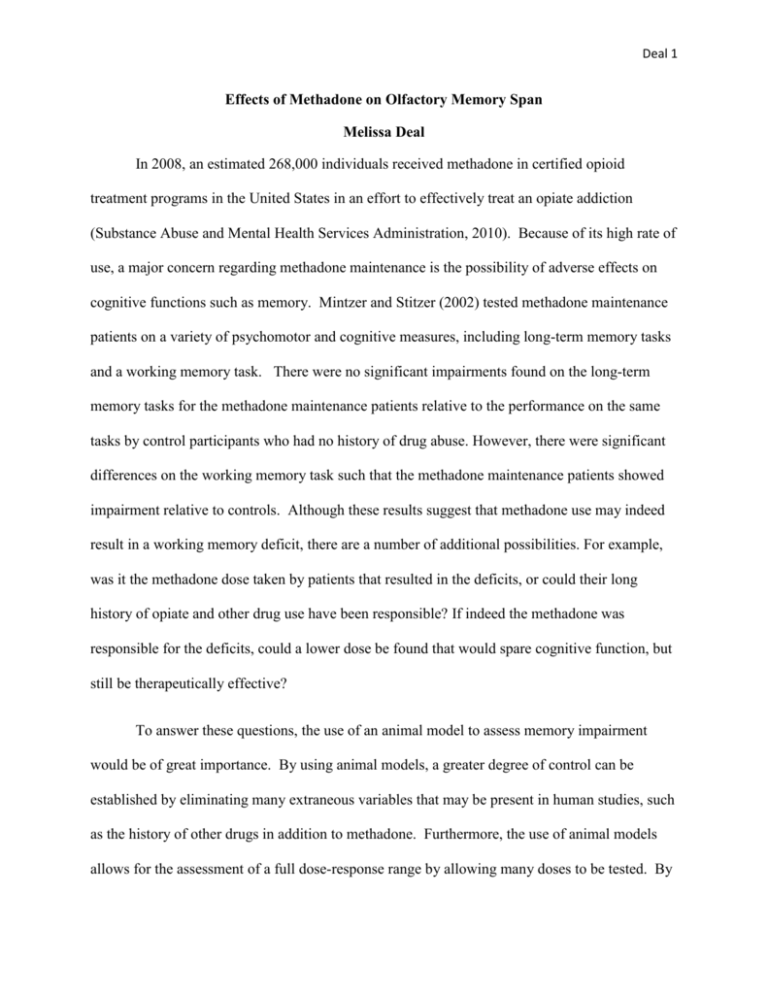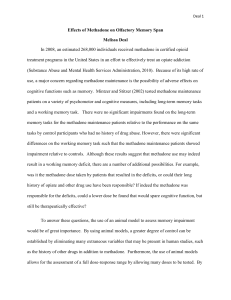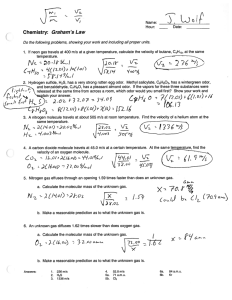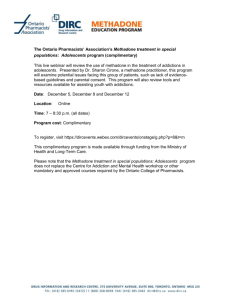Effects of Methadone on Olfactory Memory Span
advertisement

Deal 1 Effects of Methadone on Olfactory Memory Span Melissa Deal In 2008, an estimated 268,000 individuals received methadone in certified opioid treatment programs in the United States in an effort to effectively treat an opiate addiction (Substance Abuse and Mental Health Services Administration, 2010). Because of its high rate of use, a major concern regarding methadone maintenance is the possibility of adverse effects on cognitive functions such as memory. Mintzer and Stitzer (2002) tested methadone maintenance patients on a variety of psychomotor and cognitive measures, including long-term memory tasks and a working memory task. There were no significant impairments found on the long-term memory tasks for the methadone maintenance patients relative to the performance on the same tasks by control participants who had no history of drug abuse. However, there were significant differences on the working memory task such that the methadone maintenance patients showed impairment relative to controls. Although these results suggest that methadone use may indeed result in a working memory deficit, there are a number of additional possibilities. For example, was it the methadone dose taken by patients that resulted in the deficits, or could their long history of opiate and other drug use have been responsible? If indeed the methadone was responsible for the deficits, could a lower dose be found that would spare cognitive function, but still be therapeutically effective? To answer these questions, the use of an animal model to assess memory impairment would be of great importance. By using animal models, a greater degree of control can be established by eliminating many extraneous variables that may be present in human studies, such as the history of other drugs in addition to methadone. Furthermore, the use of animal models allows for the assessment of a full dose-response range by allowing many doses to be tested. By Deal 2 testing many doses, it may be possible for a safe dose to be determined; that is, a dose that effectively prevents withdrawal from opiates in a patient, but at the same time does not produce any impairment in cognitive functioning. Historically, it has been difficult to develop non-human models of what is often referred to as “working” or “short-term” memory in humans. However, Dudchenko, Wood, and Eichenbaum (2000) have developed a task to measure similar processes in rats using olfactory stimuli. In this procedure (illustrated in Figure 1), a cup filled with sand scented with an odor (A) is presented to the rat in an open-field arena. Digging in the cup is reinforced with a food pellet and signals trial termination. The rat is then removed from the arena and two cups with scented sand are arranged for the second trial. In trial 2, the odor from trial one (A) is presented again, but with a novel odor (B), as well. A response to the novel odor is reinforced. On trial 3, the odors A and B from the previous trials are again presented along with another novel odor (C). Again, a response to the novel odor is reinforced. As the session continues, each subsequent trial includes all of the previously presented stimuli to which responses are never reinforced and one novel odor to which responses are always reinforced. Thus, the rat must remember the previously presented stimuli in order to respond correctly to the novel one, and because the number of stimuli to remember increases, the rat’s working memory capacity can be assessed. Figure 1. On Trial one, the rat is presented with Odor A. Digging in the cup is reinforced and terminates the trial. On Trial 2 (Span 1), Odor B, a novel odor, is presented, along with Odor A from the previous trial. A response to Odor B is reinforced. A novel odor is added to the arena in each additional trial and a response to the novel odor is always reinforced. Therefore, the rat must remember the odors that have been presented previously and to respond only to the novel odor (from Dudchenko et al., p. 2965). Deal 3 The proposed research will use a variation of the Dudchenko et al. procedure as a drug baseline to test the effects of methadone on working memory in rats. Methods Subjects Subjects will be eight Harlan Sprague-Dawley rats. They will be housed individually on a reversed 12-hr. light –dark cycle. Subjects will be maintained on a restricted diet of Purina Lab Chow (daily in the home cage) and sucrose pellets (used as reinforcement during the experiment). Rats will be maintained slightly below their free feeding weight so that they will be motivated to consume pellets during the experiment. Apparatus The apparatus is a circular arena (94 cm in diameter, 29 cm high) with 18 holes spaced 13cm apart. Plastic cups are inserted into the holes for stimulus presentation. Opaque plastic lids stored in containers with various household spices are used for olfactory stimuli presentation. Cups used for stimuli presentation are partially filled with sand and a sucrose pellet is placed on the surface of the sand for the correct stimulus. Procedure The first trial of each session begins with one scent present in the arena. Scents are presented by covering plastic cups, partially filled with sand, with plastic lids that have been stored in containers with various household spices. The remaining 17 holes in the arena are filled with empty plastic cups. A response, defined as removal of the lid with the face, snout, or front paws, to the scented lid is reinforced by a sucrose pellet which is present on the surface of Deal 4 the sand in the cup and is retrievable once the lid has been displaced. The rat is then removed from the arena and placed in a holding cage for an ITI of approximately one minute. For the second trial, a new odor is introduced by presenting another cup with a scented lid, and a response to the novel odor is again reinforced. During this trial the odor from the first trial is again present for comparison. On each additional trial, one new odor is added and a response to the novel stimulus is always reinforced. In order to control for possible scent marking of the lids/cups, stimulus lids are replaced after each trial with new scented lids. In order to control for the possibility of the rat simply responding to the odor of the food pellet, several trials with no food pellet are intermixed in each session. On these “no bait” control trials, the food pellet is delivered by tweezers to the rat after the correct response. A correct response is scored when the rat removes the lid of the novel stimulus first. An error is scored when the rat first removes the lid of one of the previously presented stimuli. A correction procedure is also used so that a trial continues even after a response to an incorrect stimulus, until a response to the correct stimulus is made. Essentially, the rat must remember previously presented odors within the session and always respond to the novel one. Therefore, as the session progresses the number of odors that the animal must remember also increases. Location for the correct stimulus is chosen pseudorandomly, with the constraint that no location contains the correct stimulus more than two times consecutively. Locations for the incorrect stimuli are chosen randomly. Dependent measures include overall percent correct and olfactory memory span, defined as the number of stimuli incremented without error. Latency from placement into the arena until the rat makes its first response will also be recorded as a general measure of performance impairment. Once a stability criterion is met, subjects will be given twice weekly i.p. injections of methadone at 1.0, 3.0, 5.0, 8.0, or 10.0 mg/kg 15 minutes prior to testing. Deal 5 Doses chosen for this study are based on previous research that demonstrated methadone effects in this dose range (Steinpreis, Rutell, & Parrett, 1996). Olfactory span data will be analyzed using a one way ANOVA using drug doses as the independent variable. As drug dose increases, a decrease in span is predicted. A one way ANOVA will also be used to determine the effects of drug dose on latency. In order to assess the effects of drug dose on accuracy as a function of the number of stimuli to remember, percent correct will be computed across the session and analyzed with a dose x trial factorial ANOVA. At large doses, a decrease in both span and percent correct is predicted. However, because an increase in latency is also expected at these doses and because a decrease in percent correct is expected even when the memory load is small, the impairment shown may not be specific to working memory but will instead demonstrate an overall impairment. Conversely, an effect specific to working memory at intermediate doses is predicted. That is, at intermediate doses an increase in latency is not expected, while a decrease in percent correct is expected, but only when the memory load is high. Data collected from this experiment will be used for several projects. First, the entire experiment, including results, will be presented in detail in my honors thesis. Data will also be displayed on a poster for presentation at scholarly conferences. Also, if this research yields significant results, publication in a scholarly journal is possible. Deal 6 References Dudchenko, P.A., Wood, E.R., & Eichenbaum, H. (2000). Neurotoxic Hippocampal Lesions Have No Effect on Odor Span and Little Effect on Odor Recognition Memory But Produce Significant Impairments on Spatial Span, Recognition, and Alternation. The Journal of Neuroscience, 20(8), 2964-2977. Mintzer, M., & Stitzer, M. (2002). Cognitive Impairment in Methadone Maintenance Patients. Drug and Alcohol Dependence, 67(1), 41-51. Steinpreis, R. E., Rutell, A.L., & Parrett, F. A. (1996). Methadone produces conditioned place preference in the rat. Pharmacology Biochemistry, and Behavior, 54(2), 339-341. Substance Abuse and Mental Health Services Administration, The N-SSATS Report. (2010). National Survey of Substance Abuse Treatment Services. Retrieved from http://ncadistore.samhsa.gov/catalog/productDetails.aspx?ProductID=18261







